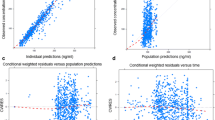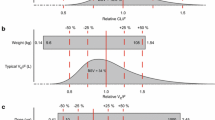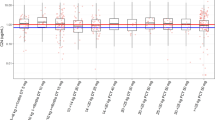Abstract
Aims
Nevirapine is the first non-nucleoside reverse-transcriptase inhibitor approved and is widely used in combination therapy to treat HIV-1 infection. The pharmacokinetics of nevirapine was extensively studied in various populations with a parametric approach. Hence, this study was aimed to determine population pharmacokinetic parameters in Malaysian HIV-infected patients with a non-parametric approach which allows detection of outliers or non-normal distribution contrary to the parametric approach.
Methods
Nevirapine population pharmacokinetics was modelled with Pmetrics. A total of 708 observations from 112 patients were included in the model building and validation analysis. Evaluation of the model was based on a visual inspection of observed versus predicted (population and individual) concentrations and plots weighted residual error versus concentrations. Accuracy and robustness of the model were evaluated by visual predictive check (VPC). The median parameters’ estimates obtained from the final model were used to predict individual nevirapine plasma area-under-curve (AUC) in the validation dataset. The Bland-Altman plot was used to compare the AUC predicted with trapezoidal AUC.
Results
The median nevirapine clearance was of 2.92 L/h, the median rate of absorption was 2.55/h and the volume of distribution was 78.23 L. Nevirapine pharmacokinetics were best described by one-compartmental with first-order absorption model and a lag-time. Weighted residuals for the model selected were homogenously distributed over the concentration and time range. The developed model adequately estimated AUC.
Conclusions
In conclusion, a model to describe the pharmacokinetics of nevirapine was developed. The developed model adequately describes nevirapine population pharmacokinetics in HIV-infected patients in Malaysia.





Similar content being viewed by others
References
MOH (2014) Global AIDS Response Progress Report 2014 Malaysia
MOH (2012) Global AIDS Response 2012. Country Progress Report, Malaysia
Pollard RB, Robinson P, Dransfield K (1998) Safety profile of nevirapine, a nonnucleoside reverse transcriptase inhibitor for the treatment of human immunodeficiency virus infection. Clin Ther 20:1071–1092. doi:10.1016/S0149-2918(98)80105-7
Lian L.M., Kamarudin A., Siti Fauziah A, et al. (2013) Malaysian Statistics On Medicines 2008. Pharmaceutical Services Division and The Clinical Reaserch Centre Ministry Of Health Malaysia.
WHO Collaborating Centre (2003) Introduction to drug utilization research
Bova CA, Pav JW, Roy T et al (1993) Single-rising-dose study in humans. Pharmacokinetics of nevirapine : initial single-rising-dose study in humans. Antimicrob Agents Chemother. doi:10.1128/AAC.37.2.178.Updated
Kou H, Du X, Li Y et al (2013) Comparison of nevirapine plasma concentrations between lead-in and steady-state periods in Chinese HIV-infected patients. PLoS One 8:e52950. doi:10.1371/journal.pone.0052950
Micheli JE, Chinn LW, Shugarts SB et al (2013) Measuring the overall genetic component of nevirapine pharmacokinetics and the role of selected polymorphisms: towards addressing the missing heritability in pharmacogenetic phenotypes? Pharmacogenet Genomics 23:591–596. doi:10.1097/FPC.0b013e32836533a5
Cohen K, van Cutsem G, Boulle A et al (2008) Effect of rifampicin-based antitubercular therapy on nevirapine plasma concentrations in South African adults with HIV-associated tuberculosis. J Antimicrob Chemother 61:389–393. doi:10.1093/jac/dkm484
Wattanakul T, Avihingsanon A, Manosuthi W, Punyawudho B (2014) Population pharmacokinetics of nevirapine in Thai HIV-infected patients. Antivir Ther 19:651–660. doi:10.3851/IMP2741
Chou M, Bertrand J, Segeral O et al (2010) Population pharmacokinetic-pharmacogenetic study of nevirapine in HIV-infected cambodian patients. Antimicrob Agents Chemother 54:4432–4439. doi:10.1128/AAC.00512-10
Suzana M, Nazirah WYW, Badriah HN (2014) Development and validation of HPLC-UV method for simultaneous determination of nevirapine, 2-OH nevirapine and 3-OH nevirapine in human plasma. Int J PharmTech Res 6:49
Musa N, Zulkafli MI, Talib N et al (2012) Haplotypes frequencies of CYP2B6 in Malaysia. J Postgrad Med 58:235–241. doi:10.4103/0022-3859.105439
Neely MN, van Guilder MG, Yamada WM et al (2012) Accurate detection of outliers and subpopulations with Pmetrics, a nonparametric and parametric pharmacometric modeling and simulation package for R. Ther Drug Monit 34:467–476. doi:10.1097/FTD.0b013e31825c4ba6
Jelliffe RW, Schumitzky A, Bayard D et al (2015) Describing assay precision-reciprocal of variance is correct, not CV percent: its use should significantly improve laboratory performance. Ther Drug Monit 37:389–394. doi:10.1097/FTD.0000000000000168
Cockcroft D, Gault M (1976) Prediction of creatinine clearance from serum creatinine. Nephron 16:31–41
Goutelle S, Bourguignon L, Maire PH et al (2009) Population modeling and Monte Carlo simulation study of the pharmacokinetics and antituberculosis pharmacodynamics of rifampin in lungs. Antimicrob Agents Chemother 53:2974–2981. doi:10.1128/AAC.01520-08
Jelliffe R, Bayard D, Milman M et al (2000) Achieving target goals most precisely using nonparametric compartmental models and “multiple model” design of dosage regimens. Ther Drug Monit 22:346–353
Bustad A, Terziivanov D, Leary R et al (2006) Parametric and nonparametric population methods: their comparative performance in analysing a clinical dataset and two Monte Carlo simulation studies. Clin Pharmacokinet 45:365–383. doi:10.2165/00003088-200645040-00003
Alghanem S, Neely M, Thomson A (2013) Population Approach Group Europe 22nd Meeting. Comparison of NONMEM and Pmetrics Analysis of Aminoglycoside Pharmacokinetics in Adult Patients with Cystic Fibrosis
Woillard J-B, Lebreton V, Neely M et al (2014) Pharmacokinetic tools for the dose adjustment of ciclosporin in haematopoietic stem cell transplant patients. Br J Clin Pharmacol 78:836–846. doi:10.1111/bcp.12394
de Maat MMR, Huitema ADR, Mulder JW et al (2002) Population pharmacokinetics of nevirapine in an unselected cohort of HIV-1-infected individuals. Br J Clin Pharmacol 54:378–385
Moltó J, Valle M, Miranda C et al (2008) Once- or twice-daily dosing of nevirapine in HIV-infected adults: a population pharmacokinetics approach. J Antimicrob Chemother 62:784–792. doi:10.1093/jac/dkn268
Schipani A, Wyen C, Mahungu T et al (2011) Integration of population pharmacokinetics and pharmacogenetics: an aid to optimal nevirapine dose selection in HIV-infected individuals. J Antimicrob Chemother 66:1332–1339. doi:10.1093/jac/dkr087
Elsherbiny D, Cohen K, Jansson B et al (2009) Population pharmacokinetics of nevirapine in combination with rifampicin-based short course chemotherapy in HIV- and tuberculosis-infected South African patients. Eur J Clin Pharmacol 65:71–80. doi:10.1007/s00228-008-0481-y
Chantarangsu S, Cressey TR, Mahasirimongkol S et al (2009) Influence of CYP2B6 polymorphisms on the persistence of plasma nevirapine concentrations following a single intra-partum dose for the prevention of mother to child transmission in HIV-infected Thai women. J Antimicrob Chemother 64:1265–1273. doi:10.1093/jac/dkp351
Saitoh A, Sarles E, Capparelli E et al (2007) CYP2B6 genetic variants are associated with nevirapine pharmacokinetics and clinical response in HIV-1-infected children. AIDS (London, England) 21:2191–2199. doi:10.1097/QAD.0b013e3282ef9695
Bertrand J, Chou M, Richardson DM et al (2012) Multiple genetic variants predict steady-state nevirapine clearance in HIV-infected Cambodians. Pharmacogenet Genomics 22:868–876. doi:10.1097/FPC.0b013e32835a5af2
Dickinson L, Chaponda M, Carr DF et al (2014) Population pharmacokinetic and pharmacogenetic analysis of nevirapine in hypersensitive and tolerant HIV-infected patients from Malawi. Antimicrob Agents Chemother 58:706–712. doi:10.1128/AAC.02069-13
Kappelhoff BS, Leth F Van, Macgregor TR, Beijnen JH (2005) Nevirapine and efavirenz pharmacokinetics and covariate analysis in the 2NN study. Antivir Ther 145–155
de Maat MMR, ter Heine R, Mulder JW et al (2003) Incidence and risk factors for nevirapine-associated rash. Eur J Clin Pharmacol 59:457–462. doi:10.1007/s00228-003-0613-3
Wang J, Kou H, Fu Q et al (2011) Nevirapine plasma concentrations are associated with virologic response and hepatotoxicity in Chinese patients with HIV infection. PLoS One 6:e26739. doi:10.1371/journal.pone.0026739
Acknowledgments
This work was financially supported by Universiti Sains Malaysia RU Grant (grant no. 1001/PSK/8620015). The first author was supported by Malaysia Ministry of Health Hadiah Latihan Persekutuan. The authors thank Dr Mahiran Mustafa (HRPZ II), Dr Ahmad Kashfi Ab Rahman (HSNZ) and Dr Low Lee Lee (HSB) for their co-operation in conducting the research. The authors also acknowledge staff members of INFORMM (USM), Kelantan, nurses and pharmacists of Infectious Disease Clinics of HRPZ II, HSNZ and HSB, Malaysia for their support and help.
Author information
Authors and Affiliations
Corresponding author
Ethics declarations
Competing interests
The authors declare that they have no conflict of interest.
Rights and permissions
About this article
Cite this article
Mustafa, S., Yusuf, W.N.W., Woillard, J.B. et al. Population pharmacokinetics of nevirapine in Malaysian HIV patients: a non-parametric approach. Eur J Clin Pharmacol 72, 831–838 (2016). https://doi.org/10.1007/s00228-016-2049-6
Received:
Accepted:
Published:
Issue Date:
DOI: https://doi.org/10.1007/s00228-016-2049-6




